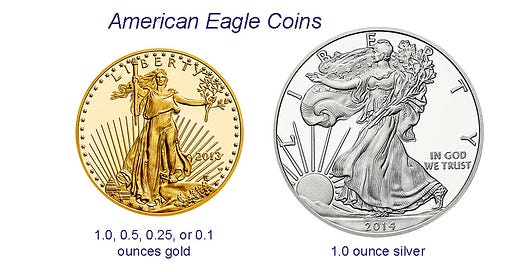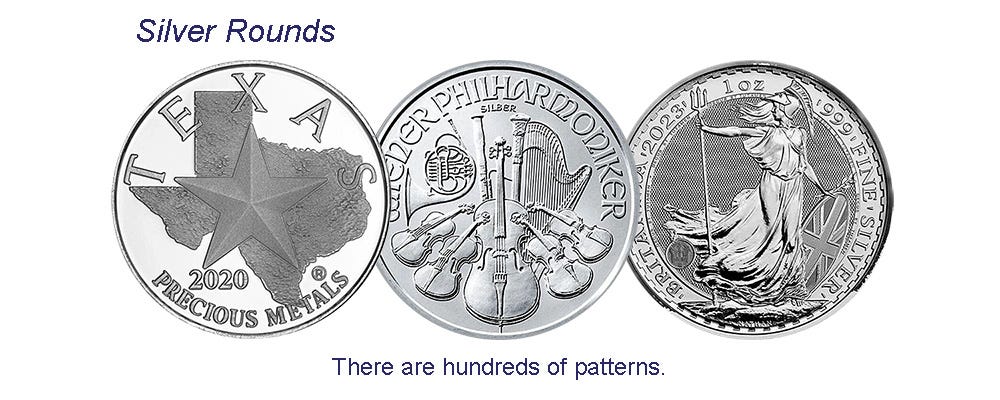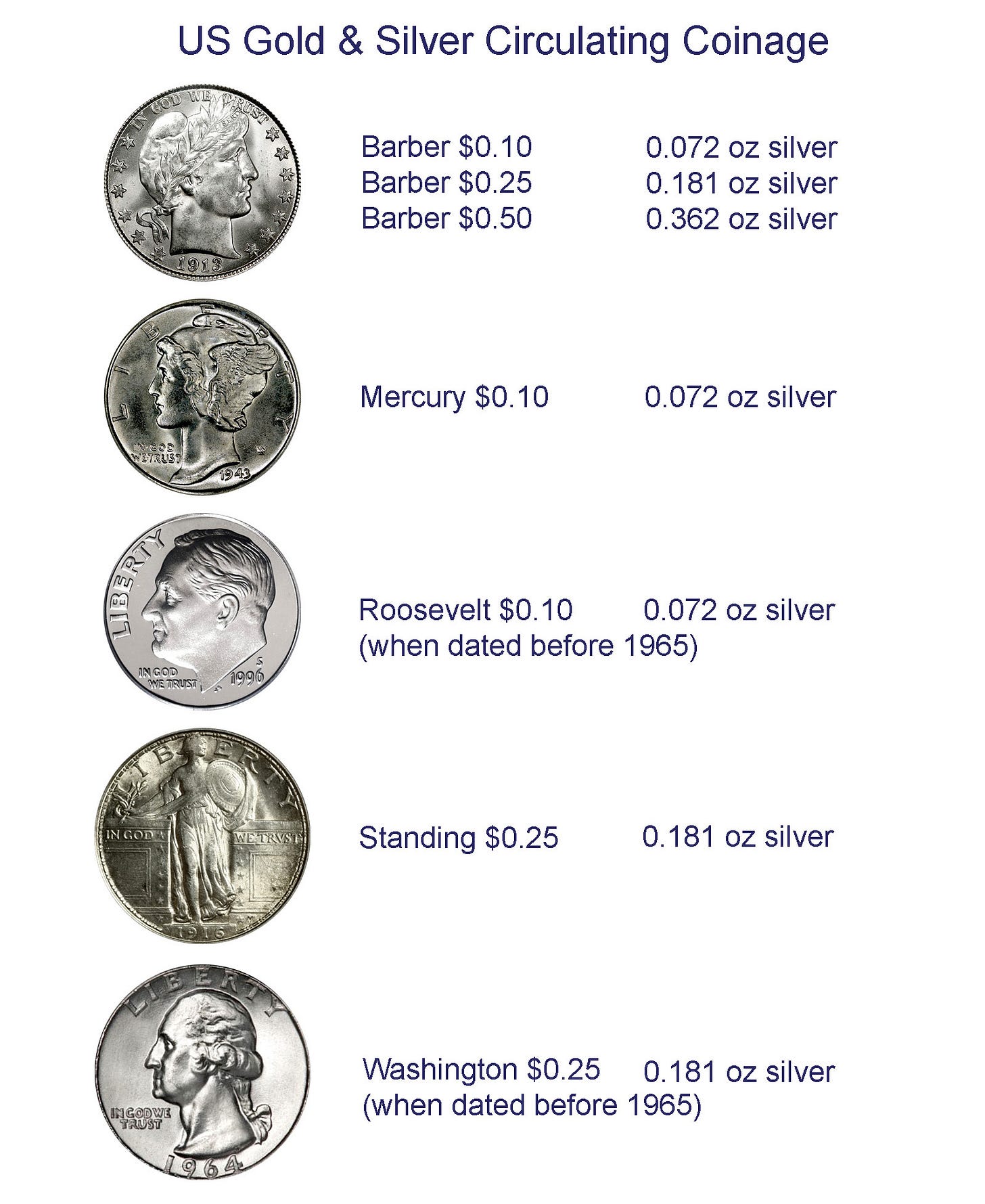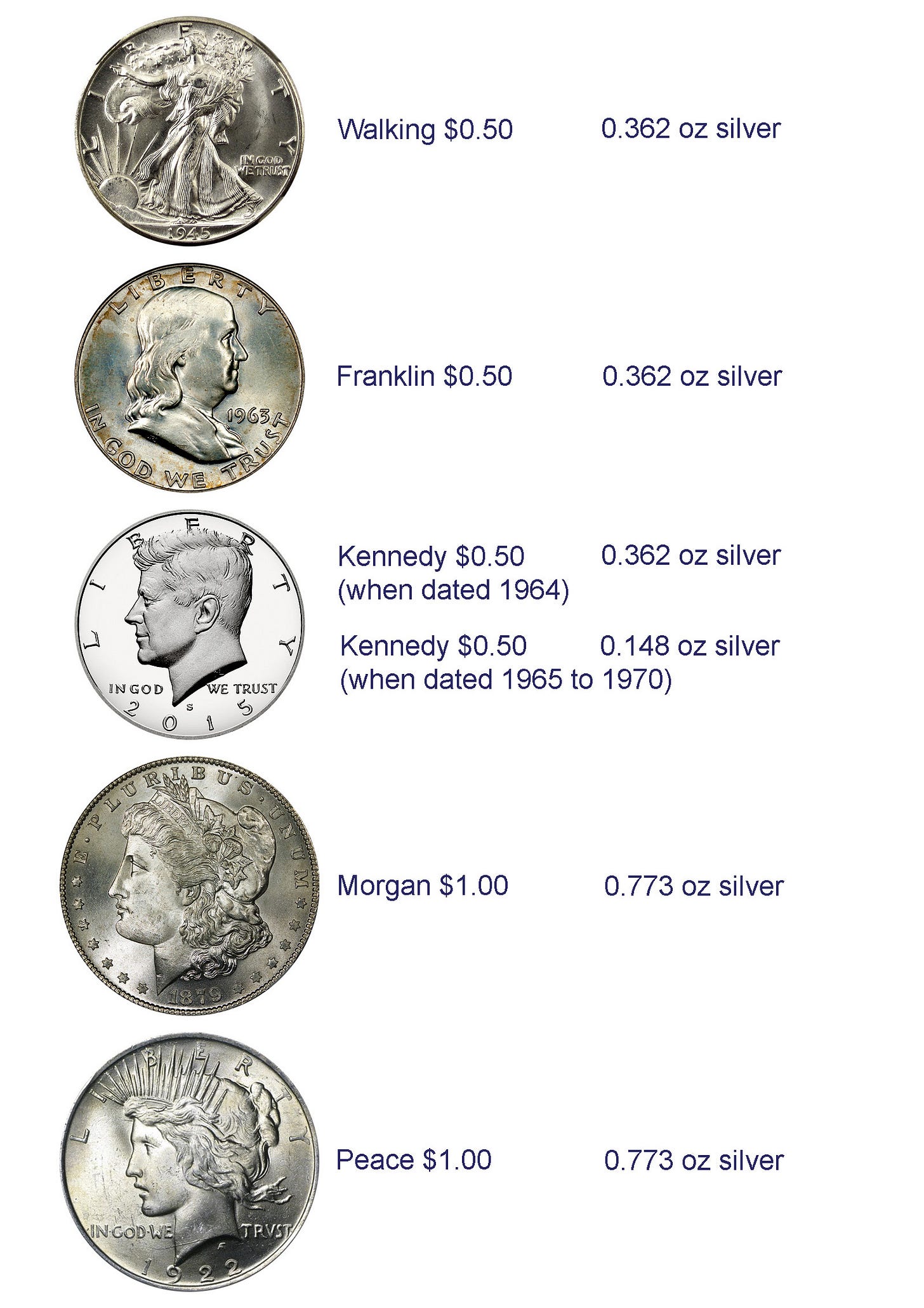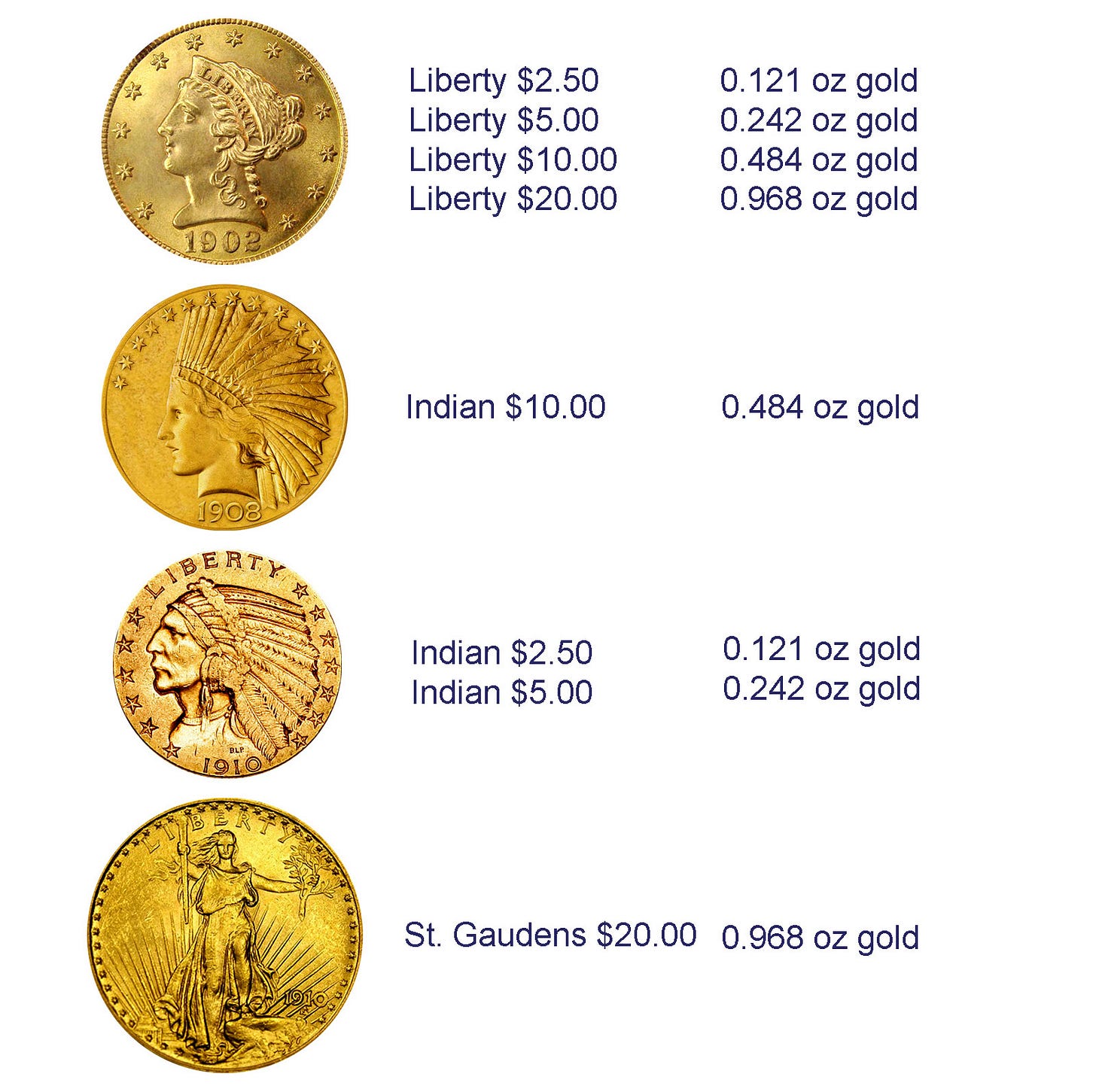When coins are made of gold or silver, they are valuable regardless of date, mint mark, type, or condition. The value comes from the precious metal they contain.
Use this article to tally up the number of ounces of precious metal in your collection and, once tallied, get the actual value in dollars. Alternately, use the article to learn the basics of gold and silver investing.
There are Ounces and there are Ounces - If you find American Eagles among your coins, or other “bullion coins” made for investing, read the inscriptions on the coins to get the precise amount of gold or silver they contain. Remember, precious metals are measured in troy ounces, or just “ounces” where the “troy” is understood.
Troy ounces are different than ounces you use in the kitchen. If your gold coin says one ounce of gold, it has one troy ounce of gold. If a package of hamburger says 16 ounces of hamburger, it has 16 avoirdupois ounces of hamburger. A troy ounce is about 10 percent heavier than an avoirdupois ounce.
Curiously, there are 12 troy ounces in one troy pound. Be careful. If someone tries to sell you “a full pound” of silver, you are getting only 12 ounces of silver, not 16. People are fooled by this rip-off scheme all the time.
If there are no inscriptions, or if the pattern is different than those shown above, you have a look-alike “round” which is not an American Eagle. There are hundreds of beautiful patterns on rounds, but investors generally prefer American Eagles or other bullion coins issued by reliable governments. The gold and silver content in rounds is not guaranteed, but the gold and silver content of American Eagles is guaranteed by the US government.
Gold and silver rounds are valuable. The precious metal content is usually marked on them. If not, use a gold or silver eagle as comparison to estimate the ounces.
“Spot” Value - Precious metals are, well, precious. Their price changes each day. A good place to find the current “spot” value of gold and silver is Kitco. When the article was written, gold was trading at $2326 US dollars per troy ounce and silver was trading at $29.08 per troy ounce. Right now, the prices are different, so be sure to look them up.
At a $29 silver price, a $10 roll of pre-1965 US quarters is worth about $250. Not too shabby … especially since the original roll of quarters costs $10.
But the spot value is not the same as actual buy or sell value. Actual dollar values are explained below.
Circulating US Coinage - Our graphics which follow show gold and silver content, in troy ounces, of commonly available US coinage.
During the mid-1960s, governments around the world abandoned the idea of making circulating coins out of precious metal, so coins dated after that time contain no precious metal at all. Too bad.
Check out the pictures. Do you have any of these coins?
Now is the time to look through your collection and add up the total ounces of gold and silver in your coins. Do you have any at all? How many ounces? How much gold? How much silver? Tally ‘em up!
Holders make a Difference - Before proceeding to the pricing analysis which follows, make sure you understand it is for loose coins or coins in plain holders. Plain holders include cardboard, paper, cellophane, flexible plastic and some numismatic slabs. The analysis also applies to coins in Original Government Packaging from the US Mint, which is often made of hard plastic.
When figuring value of gold and silver coins, don’t include coins in numismatic slabs because those are usually worth more than the standard coins analyzed below. This is only the case, however, when the slabs are from PCGS, NCG, ICG or ANACS. Slabs from other companies are not reliable and are considered just plain holders.
Further, proof coins (coins made solely for collectors using special processes) are often worth more than standard coins made for circulation. Analyze them separately.
Dollar Value of Gold and Silver Coins
Base Value - Once you have the ounces figured out, multiply them by the “spot” price per ounce found at Kitco. If, for instance, your coins contain 8.3 ounces of silver, and if Kitco says silver is selling at $30 per ounce, the base value of your coins is 8.3 x 30 = $249. For gold it is the same thing. If Kitco says gold is selling at $2400 per ounce and you have 2.5 ounce, the base value of your coins is 2.5 x 2400 = $6000.
We call this base value, or bullion value (BV) of your coins because actual buy and sell values come from it. Sometimes BV is called the melt value, as if you took a blow torch and melted your coins into a puddle of precious metal.
In summary, the two formulas for base value are:
[BV for gold] = [ounces of gold] x [price per ounce of gold]
[BV for silver] = [ounces of silver] x [price per ounce of silver]
Ask Price and Premium Factors - Now, if you can find a collector to buy your gold and silver coins, you can usually sell them for a little more than BV. The price collectors are willing to pay is called the Ask price, and Ask is usually a little more than BV. The amount above BV is called the collector premium, which runs about 10 percent for gold coins and 25 percent for silver coins.
[Ask price for gold coins] = 1.1 x [BV for gold]
[Ask price for silver coins] = 1.25 x [BV for silver]
The premium factors (1.1 and 1.25) in the equations above vary with economic conditions, so these equations are just estimates, not set-in-stone values. The premiums also vary with the age, condition and type of the coins. If, for instance, the silver in your collection is nice-looking Standing Liberty quarters and Walking Liberty half dollars, the premium can easily grow to 1.5 or more.
Further, while spot values of gold and silver are widely known and easily found on the Internet, premium factors are often kept as trade secrets by coin dealers. Dealers need such leverage to effectively negotiate with their suppliers and customers. But any diligent buyer or seller can get an accurate idea of premium factors by comparing free-market sales data with the current base value.
Getting More Accurate Premium Factors - It takes a little work, but you can estimate current premiums by surveying selling prices and comparing them to base value. For small transactions (e.g., less than $10,000), bullion sales on eBay represent true free-market value. There is a mammoth collector following on eBay, and selling prices track free-market value precisely.
[premium factor] = [free market selling price] / BV
For instance, you can go to eBay, search for “Roosevelt dime,” and use advanced search features to find the “sold” price of specific silver coins. Don’t look at coins currently on sale at eBay, because those prices are unreliable. Look only at coins that have been sold. I did this recently and found:
150 pre-1965 Roosevelt dimes sold for $331
125 Mercury dimes sold for $322
19 American Silver Eagles for $628
2.8 ounces of American Gold Eagles for $7158
At current spot prices, the base values are
BV of 150 pre-1965 Roosevelt dimes is $313
BV of 125 Mercury dimes is $261
BV of 19 American Silver Eagles is $551
BV of 2.8 ounces of American Gold Eagles is $6153
so the premium factors are
premium factor for Roosevelt dimes is $331 / $313 = 1.05
premium factor for Mercury dimes is $322 / $261 = 1.23
premium factor for American Silver Eagles is $628 / $551 = 1.14
premium factor for American Gold Eagles is $7158 / $6153 = 1.09
What’s It Worth? - When someone asks the question “What is my coin worth?” they are usually asking “How much can I sell it for?” That depends on who you are selling to.
We have already seen that selling coins directly to collectors results in an Ask price which is a little higher than BV. But most people can’t find collectors to buy their coins, so they sell their coins to dealers instead. The price dealers pay for gold and silver coins is called the Bid price, and Bid is less than Ask. The difference between Bid and Ask is called the spread, and the spread expressed as a percentage of Ask is called the margin. Dealers need decent margins to keep their dealerships afloat.
The formulae for computing Bid price (i.e., the “what’s it worth?” price) from Ask price are:
[Bid price for silver coins] = (1 - [margin for silver]) x [Ask price for silver coins]
[Bid price for gold coins] = (1 - [margin for gold]) x [Ask price for gold coins]
But what are the margins? We need to know the margins to calculate Bid, and it is dealers who set margins for their gold and silver transactions. Dealers base their margins on economic conditions, product availability, overhead, profit, and many other factors focused on keeping the dealership solvent in a highly competitive market. No wonder margins are all over the map.
Generally speaking, margins on gold and silver coins range from a few percentage points to about 20 percentage points. If, for instance, the margin for an American Silver Eagle coin is 15 percent, and the Ask price is $35, the Bid price is
[Bid price] = (1 - 0.15) x [Ask price]
[Bid price] = 0.85 x $35
[Bid price] = $29.75
In this case, when you take your Silver Eagle to a bullion dealer, expect him or her to pay you about $30 for it.
Most bullion dealers keep their margins secret, but Golden Eagle Coins is different. They publish their margins directly on their website. Below is a graph of Golden Eagle’s margins. You can see it looks like the pattern from a shotgun blast. Dealers have a lot to consider when setting margins.
Each dot represents a single gold or bullion product. You can see an American Silver Eagle has an Ask price of about $30 and a margin of about 14 percent. In contrast, a 1-ounce American Gold Eagle has an Ask price of about $2500 and a margin of about 4 percent. Like I said, margins are all over the map. Use this graph to estimate margins for your specific situation.
Summary
Tally up ounces of gold and ounces of silver
Handle coins in numismatic slabs separately
Look up the spot value
Compute base value (BV)
Estimate premium factors
Compute Ask price based on BV and premium factors
Estimate margins
Compute Bid price based Ask price ando margins

